Why do apples turn brown? I bet your curious child has asked you that at one point or another. And perhaps he also challenged with a follow-up question – how do you prevent the apple from turning brown?
In this apple oxidation experiment, we are going to explore the chemical reaction that turns the apple brown. This is a great experiment to guide your kid through the scientific method of making an observation, asking a question, forming a hypothesis, designing an experiment, analyzing the data, and forming a conclusion.
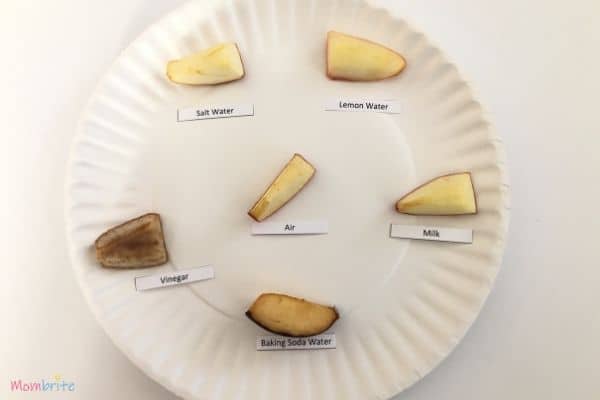
Before we start the experiment, walk your child through the scientific method.
Observation: The apple turns brown when you slice it open and leave it out.
Question: What will keep the apple from turning brown?
Hypothesis: Dipping the apple slices in a liquid will slow the browning process.
Now, let’s get to the experiment that will test the hypothesis!
How to Set Up the Apple Oxidation Experiment
Materials:
- Apple slices
- A variety of liquids. Here are what we used, but feel free to use whatever you have around the house:
- Diluted lemon juice
- Salt water
- Baking soda water
- Vinegar
- Milk
- Small containers
- Paper and pen for labeling
Directions:
- Cut out small pieces of paper and write the name of the liquids you are going to test. One of them should be “air” for your control variable. Having a control variable is necessary so that you can compare it to the other apples that have been submerged in various liquids.
- Pour the other liquids into separate containers.
- Place the labels next to the corresponding containers. You don’t want to wait to do this and forget what the liquids are later.
- Place an apple slice in each container so that it’s submerged in the liquid.
- Wait a few minutes and take out the apple slices.
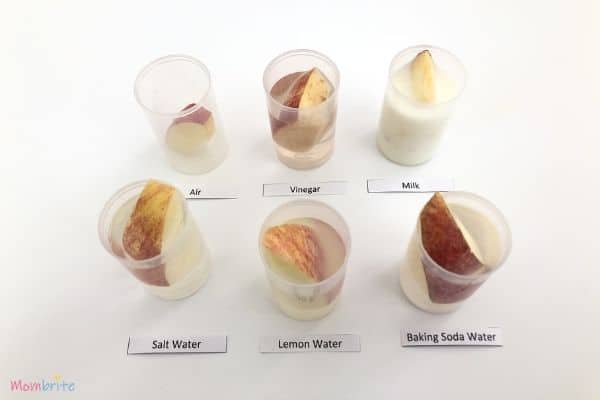
- Place the apple slices on a plate and put the corresponding labels next to them.
- Wait an hour and check on the apples. Discuss or record any new observations.
- Wait a couple more hours and check on the apples. Discuss or record any new observations.
- Leave your apple slices for a total of 5 hours. Check how brown the apple slices are and record observations.
Which apple slice browned the fastest? Slowest? Did any of them turn brown really fast but then stayed the same color by the end of 5 hours? Or did any of them turn brown slowly and ended up the darkest brown by the end of the experiment?
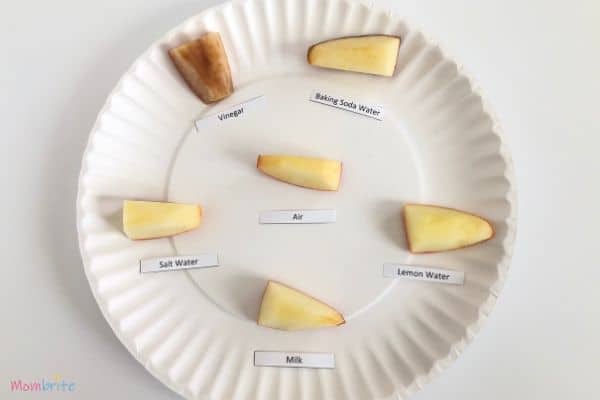
You can also lightly squish the apple slices to feel the difference in texture. The apple slice in salt water felt like a sponge. The lemon juice made the apple mushy. And last but not least, the apple slice in milk is rock hard. So interesting!
When it comes to preventing an apple slice from browning, the winner is salt water! The lemon juice was a close second. Interestingly, vinegar seemed to have accelerated the browning process instead of slowing it down.
To understand the results, let’s explore the science behind oxidation.
Science Behind Why Apples Turn Brown
Apples contain an enzyme called polyphenol oxidase (PPO). When you slice open an apple, the PPO reacts with the oxygen in the air and enzymatic browning occurs. The chemical reaction between the PPO and oxygen produces melanin, which is what gives the apple flesh the brown color.
You can slow down oxidation by not allowing oxygen to react with the PPO in the fruit. Since lemon juice worked so well, we at first thought acidic liquids, or liquids with a low pH level, would prevent the apple from browning. However, vinegar has a low pH level as well and it seemed to have accelerated the browning. So either we made an error in the experiment, or something else is at play here.
Lemon juice contains ascorbic acid or Vitamin C. Ascorbic acid will react with the oxygen before the oxygen reacts with the enzyme in the apple. Therefore, ascorbic acid will prevent the apple from browning until all the acid is used up. Vinegar does not have ascorbic acid, and therefore it did not work.
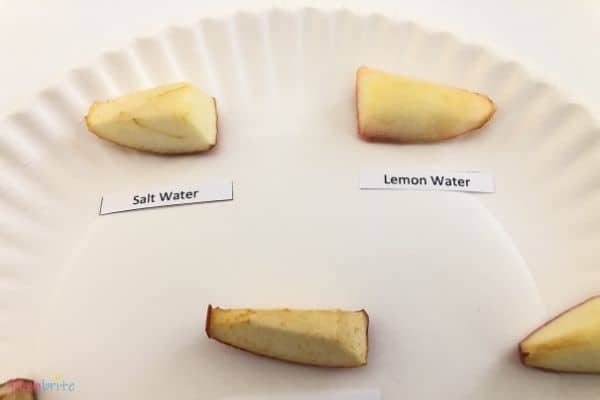
It is inconclusive why vinegar seemed to have sped up the browning. Vinegar is essentially acetic acid and water. Perhaps we need to dilute the vinegar with water? Is pure white vinegar too strong and started deteriorating the apple flesh? That’s an experiment for another day.
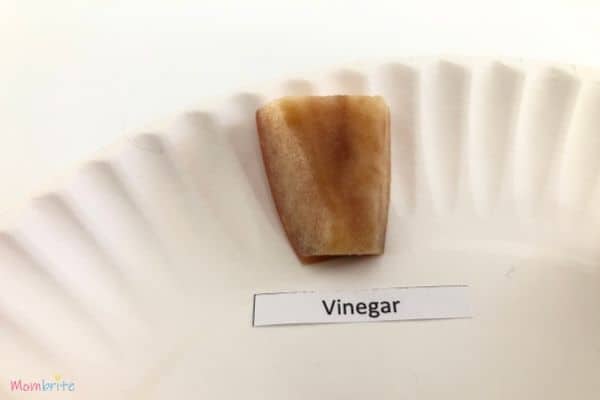
As for the baking soda and milk, they are on the other end of the pH spectrum since they are bases. Interestingly, milk did fairly well in preventing the apple from oxidizing. A future experiment can be designed to see if the fat content in the milk matters when it comes to blocking oxygen from reacting with the enzymes in the apple.
Baking soda, however, made the apple brown faster. Alkaline (high pH level) liquids contain higher amounts of oxygen. Therefore, covering the apple with baking soda solution actually brought more oxygen to the surface of the apple, accelerating the browning.
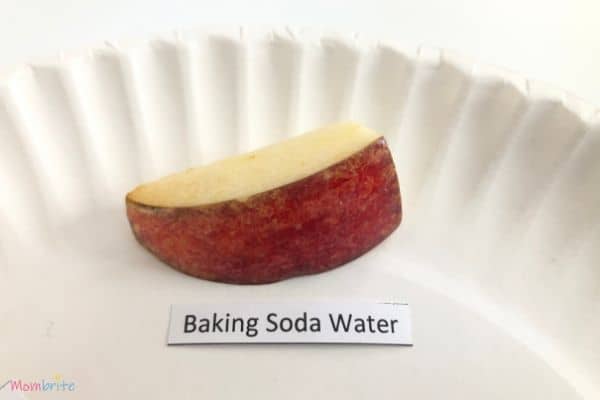
Salt water prevented the oxidation of the apple slice because it surrounded the apple cells with a saltier environment than the inside of the cells. As a result, water moves outside of the cells through osmosis in attempt to equalize the concentration of salt and water inside and outside of the cell. The water and salt on the surface of the apple slice interfere with oxygen reaching the fruit’s surface and therefore slowing down oxidation.
Final Words on the Apple Oxidation Experiment
There seem to be many ways to prevent apples from browning. Salt water seems to be the best solution, but you would need to wash the salt off the apple afterward if you don’t want the salty taste. Otherwise, lemon juice works well, but it is more expensive to use lemon juice than salt.
As you can see, there are many more experiments you can perform after this one. For example, what other fruits turn brown when exposed to air? Will salt work as well on those fruits in preventing them from browning?
I hope your kid learned the basics of the scientific method and why apples brown from this experiment. Now we know what to do with our leftover apples!
For more fall kids activities, check out:;
- Coffee Filter Fall Leaves Craft for Kids
- Apple Volcano Experiment
- Easy and Fun Paper Plate Apple Craft
- Easy 3D Paper Apple Craft for Kids
The post Apple Oxidation Science Experiment appeared first on Mombrite.
